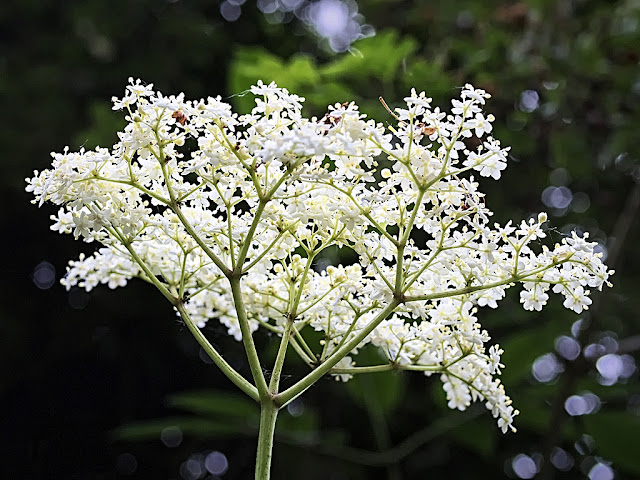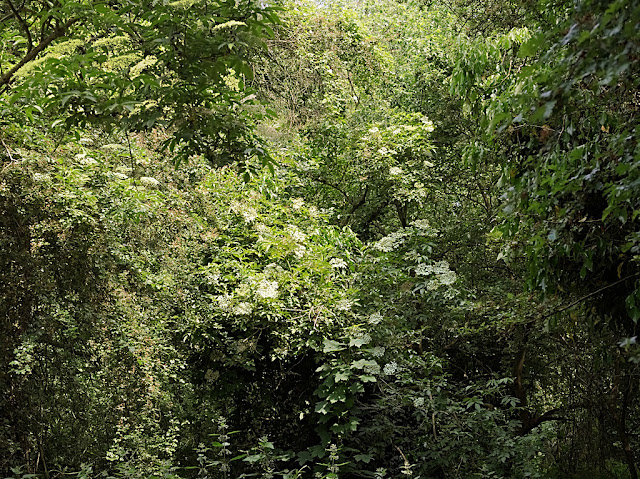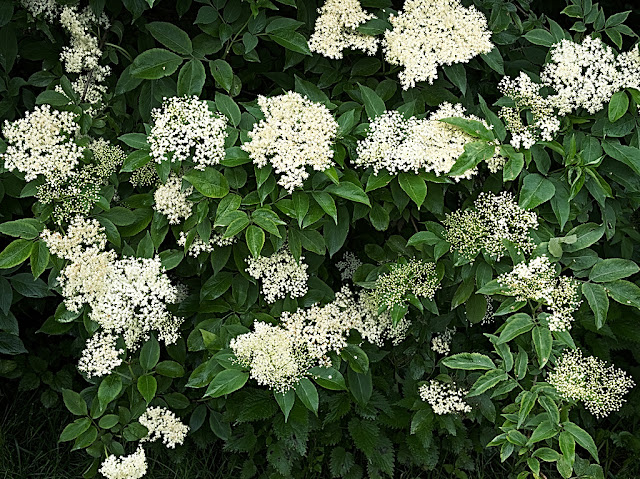 |
| 12 June 2016
Huge plates of white blossom like this are seen throughout the park in early June.
|
Plates of white elderflower blossom are seen in all the hedgerows in the park during the first weeks of June. Last year, I felt I had failed to fully capture the impact that the elderflowers have on the park.
One reason is that the blossom faces upwards, and as much of it is above head height, particularly in the hedges in the centre of the park, only the undersides of the umbels are visible.
 |
| North of Park - 8 June 2016 A lot of the elder bushes are mixed in with other bushes and climbers |
Another issue is that the elder bushes are often growing amongst some of the thickest vegetation in the park. Here the elderflowers struggle to be seen amongst hawthorn bushes, ash trees and brambles. The eye easily sees such blossom, which tends to 'disappear' when photographed.
What's in a Name?
 |
| 12 June 2016 Elderflowers can be used to make cordials, white wines and teas. |
The
name elder is thought to be derived from the Saxon word 'Aeld' or
fire. This, and the alternative name 'Ellhorn', refer either to the
use of its pithy core as tinder, or its hollowed out branches as
bellows. This is quite strange in a way, when you consider that it
was believed that burning elder brought death and disaster. One
suggested alternative derivation for 'Elder' is from 'Hylde-Moer'
the Scandinavian tree spirit who was said to inhabit elder bushes.
Food and Drink
Elder
roots, stems and leaves are all toxic. Uncooked, its flowers and
berries have an unpleasant bitter taste and contain low
concentrations of some poisons, which are destroyed by heat. With
that caveat, the flowers are used to make cordials, white wine, and
tea; the berries for jellies, jams, wines and liqueurs.
Medicine Chest
 |
| 14 August 2016 Elderberries are a rich source of vitamins A and C |
For centuries the elder tree has been known as the medicine chest, because almost every part of the bush has been used by herbalists. Some uses, for instance using the bark as a purgative, have now disappeared, and only the flowers and the berries are routinely used.
Preparations of the flowers are effective against various respiratory complaints such as coughs, colds and sinusitis. Drinking elderflower tea for two months before the pollen count rises is said to alleviate the symptoms of hay fever.
The berries are a great source of vitamins A and C. In addition,
they contain chemical compounds which reduce the duration of flu,
boost the immune system, and are beneficial to diabetics as they
stimulate glucose metabolism and the excretion of insulin.
Folklore
 |
| 8 June 2016 The wood from elders is excellent for making magic wands |
Through the ages, the elder has been hero and villain and all things between.
At first, elder was regarded as sacred to the goddess of vegetation
Hylde-Moer, and was to be honoured and treated accordingly. So, if
given suitable offerings and prayers, the elder would protect the
people who treasured it, and hence was planted around the house to
keep out evil spirits. A collateral benefit was that the elder was
never struck by lightning (or so myth had it), and hence would
protect the dwelling from that as well. This protection was for life
and beyond: green twigs were placed in coffins to protect the body
and soul on its way to the otherworld.
The
heavy smell of elderflowers was believed to be narcotic, which may
well explain why sleeping beneath the tree at midsummer was such a
good time to see fairies.
Then
along came the Christians keen to appropriate everything pagan for
themselves. So they cursed elder. It was the tree that Judas hanged
himself from. It was also, highly improbably given the lightness and
weakness of its wood, the tree from which the cross was made.
Witches could turn themselves into elder trees, and its wood was used for
making magic wands.
Elder | Trees for Life
Elder in Profile
Sambucus nigra (elder)
Elderberry
The Elder Tree
Next: Summer Flowers 2016
Sources
These snippets were gleaned from the following websites:Elder | Trees for Life
Elder in Profile
Sambucus nigra (elder)
Elderberry
The Elder Tree
Next: Summer Flowers 2016
No comments:
Post a Comment